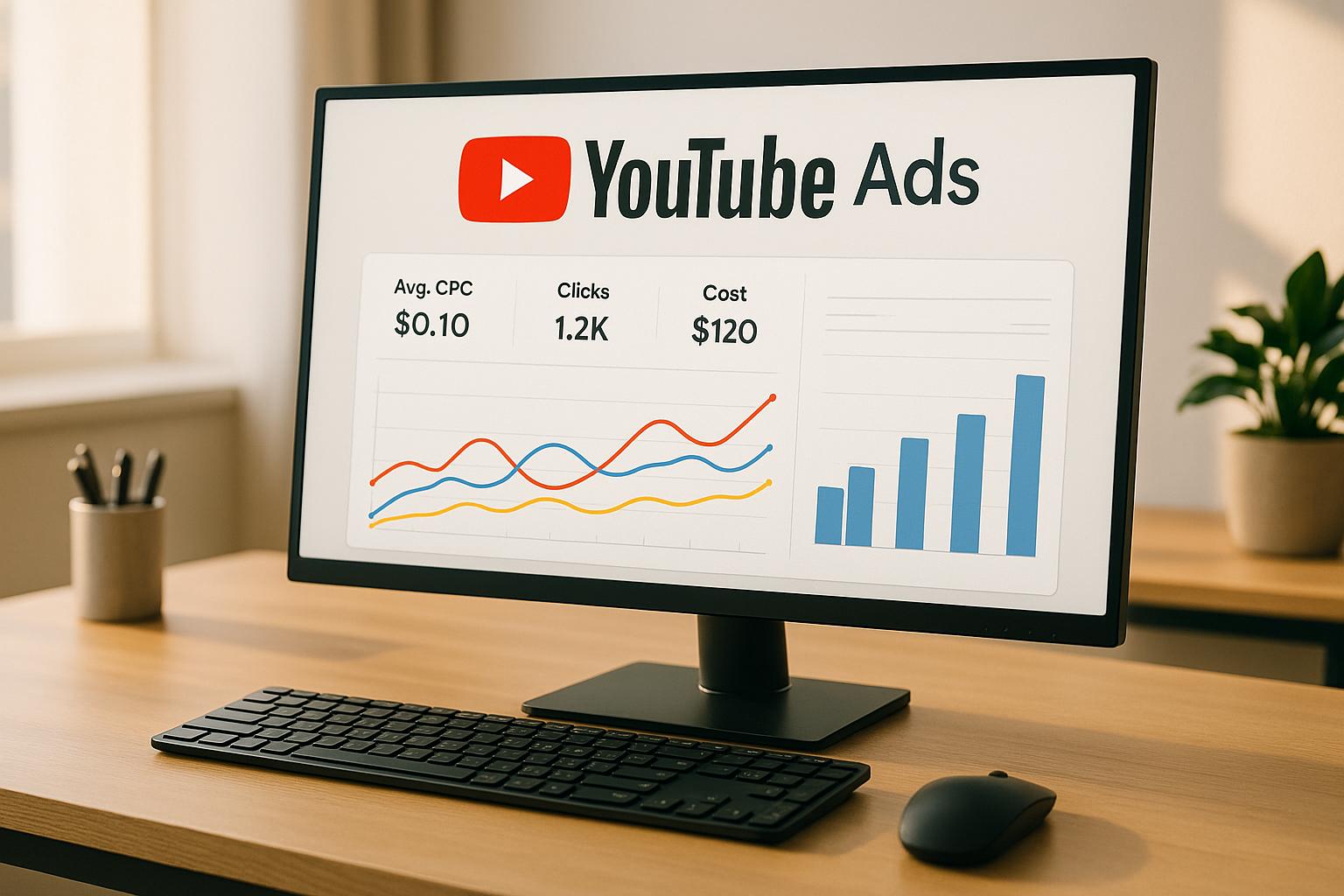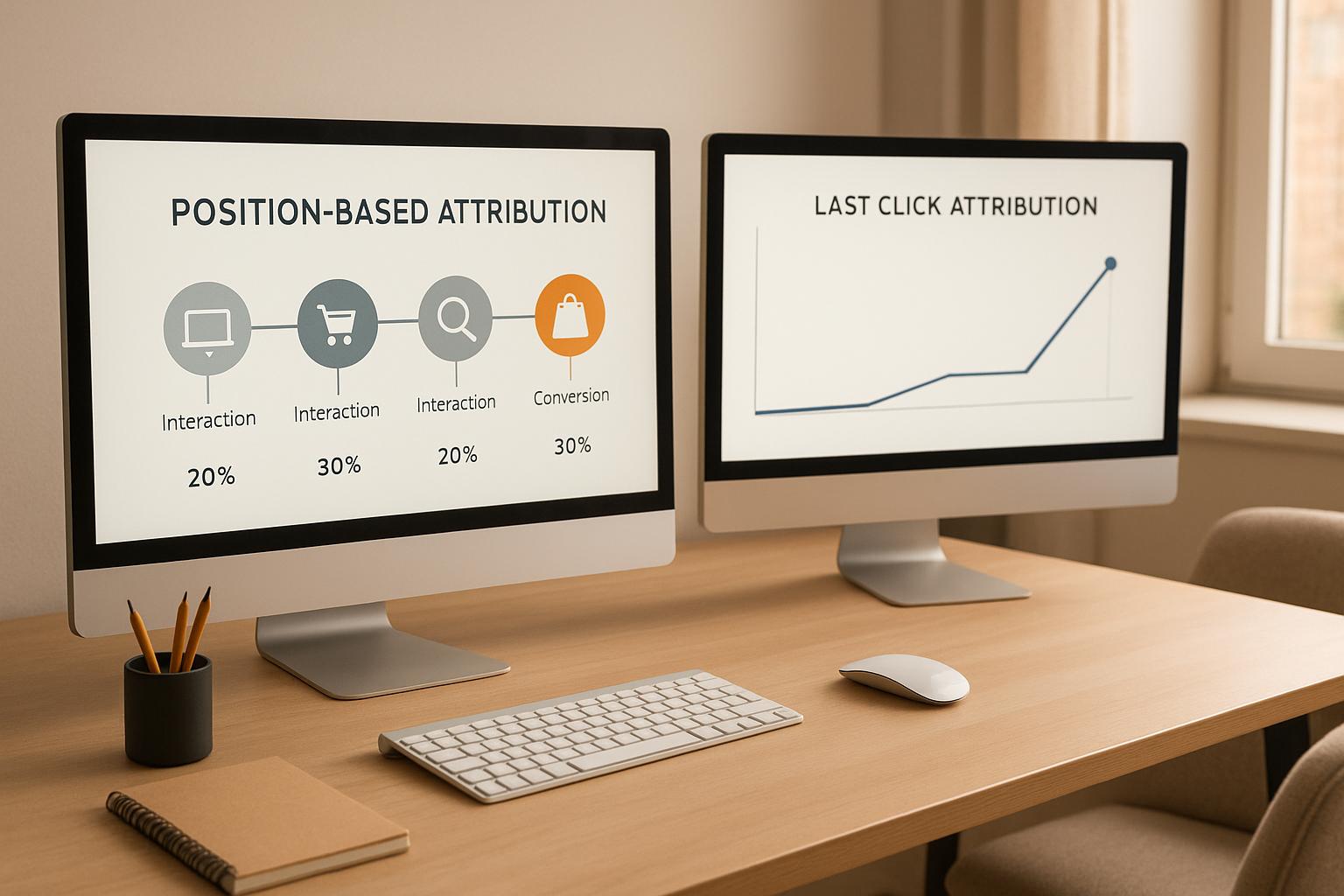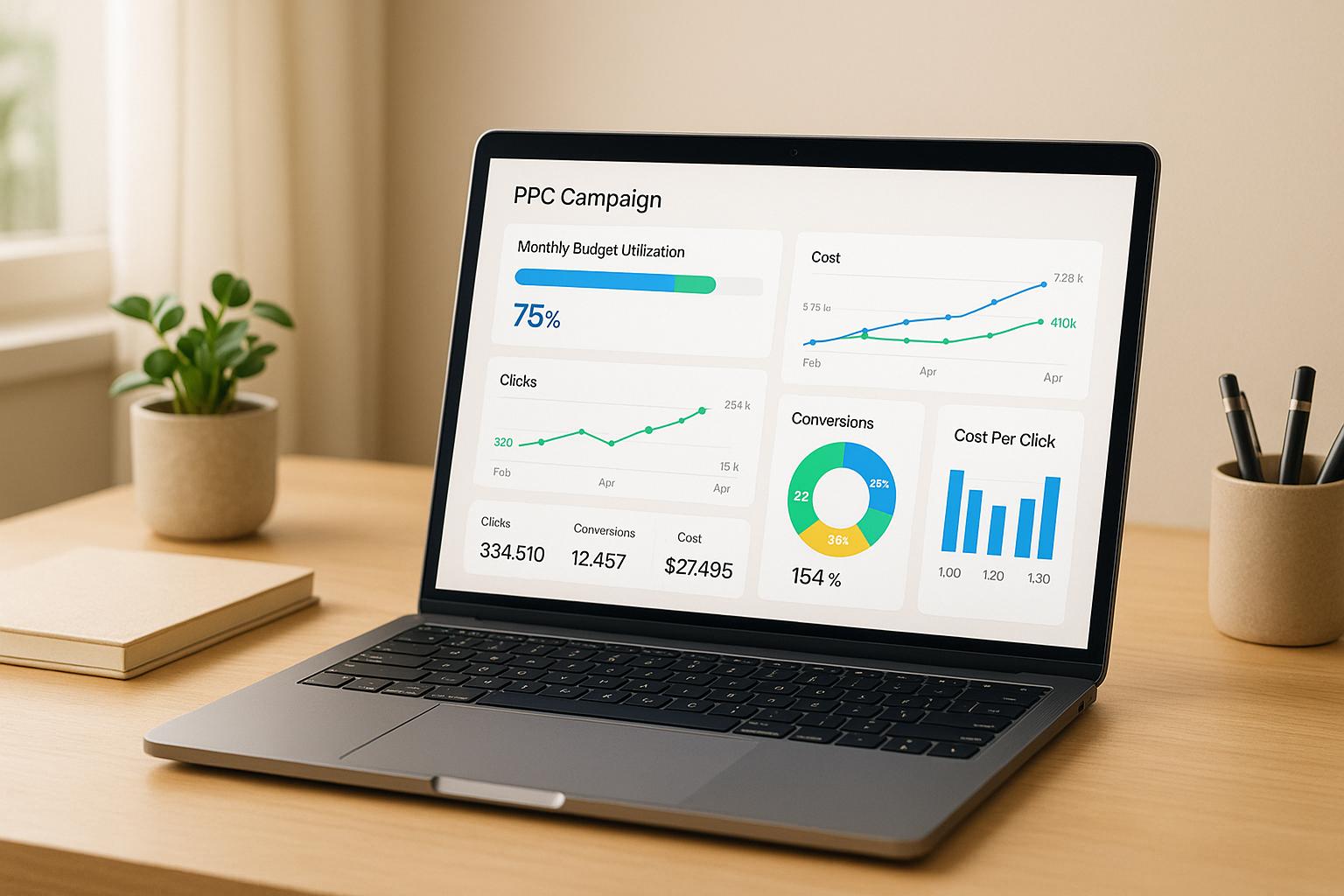Cross-device remarketing is essential for businesses aiming to reach users across smartphones, desktops, tablets, and smart TVs. With 97% of first-time visitors leaving websites without converting, tools that enable personalized, multi-device ad campaigns can boost click-through rates by 10x and increase conversions by 70%.
Here’s a quick look at seven top tools for 2025, each offering unique features for different marketing goals:
- Google Ads Remarketing: Advanced cross-device tracking using Google Signals, with AI-driven tools like Performance Max for optimized campaigns.
- Meta Retargeting: Delivers ads across Facebook, Instagram, and Messenger, leveraging AI for dynamic content and better ROAS.
- AdRoll: Focuses on unified tracking across devices and channels, integrating with platforms like Shopify and Salesforce.
- Criteo: Combines predictive AI with vast shopper data for dynamic product ads and efficient bidding.
- LeadPost: Turns anonymous site visitors into leads, syncing data with CRMs like HubSpot and Mailchimp.
- Marin Software: Manages campaigns across search, social, and display, with AI-driven budget and bid optimizations.
- OptiMonk: On-site remarketing using behavioral triggers like exit-intent popups to re-engage visitors.
Each tool caters to specific needs, from e-commerce retargeting to lead generation and cross-channel ad management. Businesses should prioritize tools with strong AI capabilities, CRM integration, and compliance with privacy standards to maximize ROI.
Cross Channel Remarketing Strategies
1. Google Ads Remarketing
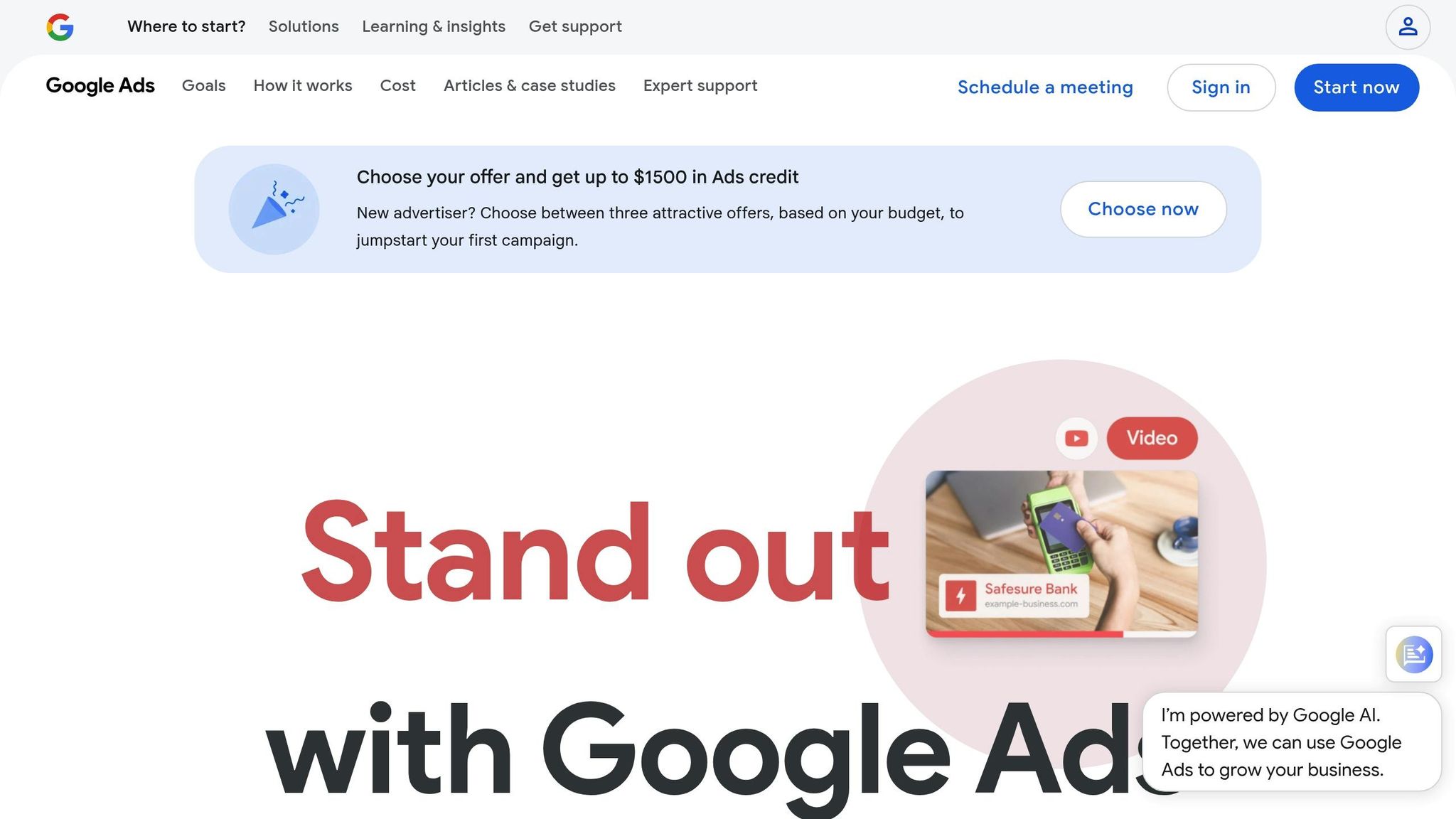
Google Ads Remarketing is a tool designed to reconnect with people who have already visited your website. Using a remarketing tag or pixel, it tracks visitors and shows them relevant ads as they browse other sites or platforms within the Google Display Network.
Cross-device capability
One standout feature of Google Ads Remarketing is its ability to track users across multiple devices. It combines two tracking methods: deterministic tracking, which uses unique identifiers like email addresses for precise accuracy, and probabilistic tracking, which relies on machine learning to analyze signals like IP addresses, device types, and browser data.
Google Signals plays a key role here, linking user activity across devices to enable more accurate retargeting. This ensures that ads follow users seamlessly as they switch between devices, offering a consistent and personalized experience. The results are impressive - conversion rates for users who interact across multiple devices are 230% higher than average.
To make the most of this cross-device capability, businesses can encourage actions like Shop Pay logins, customer account sign-ups, and collecting email or phone details at checkout. These steps help Google create more precise identity graphs, connecting multiple devices to a single user.
Supported ad channels
Google Ads Remarketing isn’t limited to display ads. It supports a variety of channels, including search, display, video, and dynamic ads. You can run remarketing campaigns on YouTube, Gmail, and other Google platforms, creating a cohesive approach to reconnect with your audience.
There are several remarketing strategies available, such as:
- Standard remarketing
- Dynamic remarketing
- Remarketing for mobile apps
- Remarketing lists for search ads (RLSA)
- Video remarketing
- Customer Match
Customer Match stands out because it allows targeting based on email addresses or phone numbers, making it particularly effective for reaching users across devices. By connecting various channels, Google Ads Remarketing mirrors today’s consumer behavior, where people often navigate multiple platforms before making a purchase. With mobile playing a bigger role in these journeys, this cross-channel approach ensures a smoother, more connected experience.
"Marketers can now tailor ad frequency based upon individuals, rather than platforms. They can capture and exploit micro-moments which allows for more strategic message delivery and sequencing." - Es Chandra, CEO of Glide
AI/automation features
Google Ads leverages AI to optimize campaigns through tools like Performance Max. This feature uses machine learning to deliver ads across all Google platforms. AI Max for Search campaigns, for example, has been shown to increase conversions or conversion value by 14% at a similar cost-per-acquisition (CPA) or return on ad spend (ROAS). For campaigns focused on exact and phrase match keywords, the improvement can jump to 27%.
Brands like L'Oréal have seen impressive results with AI Max, achieving double the conversion rate while lowering costs by 31%. They even tapped into new search queries like "what is the best cream for facial dark spots?" to drive more conversions. Similarly, MyConnect used AI Max to generate 16% more leads at a 13% lower cost-per-action, with a 30% boost in conversions from previously untapped searches.
"AI Max not only allowed us to pioneer the use of AI in Search - it also propelled us into new markets, reaching untapped audiences with lower costs, higher conversions and more relevant ad experiences that significantly boosted engagement." - Nicolás Moya, CMO, L'Oréal Chile
"With the AI-powered creative and targeting enhancements in AI Max for Search campaigns, we were able to drive incremental high-quality leads by unlocking net-new searches and having AI build more relevant content to each user and their query." - Bec Oxnam, Head of Marketing, MyConnect
Integration with CRM
Google Ads Remarketing integrates seamlessly with CRM systems, offering advanced audience segmentation and campaign optimization. Through Customer Match, businesses can upload customer data from their CRM to create highly targeted remarketing lists that work across devices.
This integration goes further with automated triggers based on specific customer actions, such as signing up for a newsletter or making a purchase. By using customer behavior and preferences, these campaigns provide a more accurate picture of the user journey compared to traditional methods reliant on third-party cookies.
2. Meta Retargeting (Facebook & Instagram)
Meta Retargeting helps reconnect with users who’ve already interacted with your website, app, or other digital channels. By tracking user behavior, it delivers tailored ads across Meta’s platforms - Facebook, Instagram, Messenger, and the Audience Network.
Cross-Device Capability
Meta’s tracking works smoothly across devices, ensuring your ads reach users whether they’re browsing on a desktop, using mobile apps, or navigating the mobile web. It collects behavioral data as users move through Meta’s ecosystem, giving you a clearer picture of how they engage with your brand. You can extend your audience retention window to 30 or 90 days, capturing those who take longer to make a decision. Cross-device reports provide insights into conversion paths, offering actionable data to fine-tune your campaigns. This tracking system supports a variety of ad formats, giving you the tools to maximize your campaign’s effectiveness.
Supported Ad Channels
Meta Retargeting spans Facebook, Instagram, Messenger, and the Audience Network, creating a well-rounded remarketing strategy. It supports multiple ad formats, including dynamic remarketing ads, which can deliver conversion rates up to five times higher than standard formats. You can also use strategies like cross-selling and upselling to increase revenue - for example, promoting items that complement a product your customer has viewed or purchased.
AI and Automation Features
Meta’s AI tools bring measurable improvements to campaign performance. Advantage+ Sales Campaigns, for instance, have shown a 22% average increase in return on ad spend (ROAS), while Advantage+ Leads Campaigns have reduced the cost per qualified lead by 10% in early tests. The Meta GEM (Generative Recommendation Model) boosts conversions by up to 5% by identifying the best combinations of headlines, descriptions, and visuals.
Real-world examples highlight the impact: In 2025, Avimee Herbal reduced the cost per sale by 62% and saw a 1.8x increase in conversions, while Big Basket improved both reach and ROI with AI-driven catalog ads.
"AI is scaling creativity in a manner never seen before, but isn't replacing the discipline. While creatives once made a few ads per year, AI now enables tens of thousands of variations daily - and more to come." – Nicola Mendelsohn, global business group head
The Opportunity Score feature further optimizes campaigns by providing real-time recommendations, helping advertisers cut costs by a median 5% per result. Meta’s AI also simplifies ad creation by generating multiple variations of images and text, all while staying true to your brand’s voice.
Integration with Analytics and CRM
Meta makes it easy to integrate with CRM systems and analytics platforms through its partner programs. You can set up tools like the Meta Pixel, offline conversions API, and Conversions API on supported platforms without needing to modify your website’s code. Third-party tools like LeadsBridge enable seamless audience data syncing between Meta and CRM platforms like ActiveCampaign, Zoho CRM, and Klaviyo. This integration ensures real-time lead capture and automated data transfers, covering everything from website and app events to offline sales and messaging interactions on Messenger, Instagram, or WhatsApp. The result? A complete view of your customers’ journeys and behaviors.
3. AdRoll
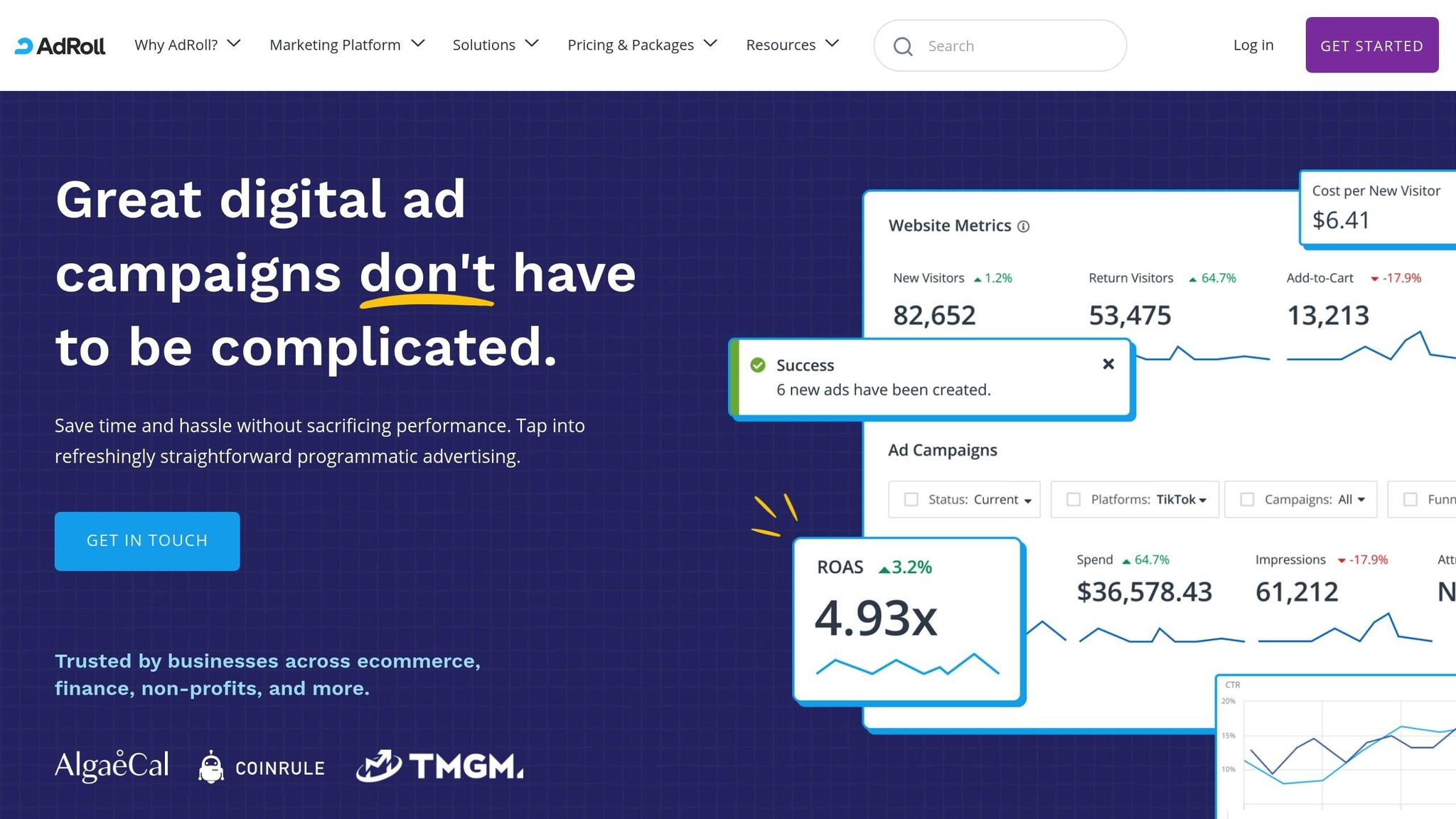
Building on Meta Retargeting's integrated approach, AdRoll steps up by focusing on seamless cross-device performance, using unified tracking and automation powered by AI.
AdRoll is a platform designed for cross-channel marketing, reconnecting with customers through web, social media, and email. It uses AI to automatically fine-tune campaigns across these channels and reportedly helps brands generate a staggering $246 billion in sales annually.
Cross-Device Capability
AdRoll tackles a common issue: around 60% of internet users start shopping on one device but complete their purchase on another. With UTM tracking, AdRoll brings all conversion data into a single, unified dashboard, offering a clear picture of the customer journey across devices. This feature eliminates the disconnect often experienced by consumers when content isn't synchronized across platforms.
Supported Ad Channels
AdRoll integrates with a vast network of websites, apps, and streaming platforms. It connects with major advertising accounts like Facebook, Instagram, TikTok, Pinterest, Google Ads, Snapchat, Amazon Ads, Microsoft Ads, LinkedIn Ads, and X Ads. Additionally, it offers a connected TV solution that extends reach to over 200 million viewers.
AI and Automation Features
AdRoll's machine learning capabilities analyze data from over 1.2 billion shoppers to deliver personalized recommendations and optimize campaign performance. Its automation builder streamlines campaigns across display and social channels, adjusting bids and targeting in real-time while tailoring ad creatives based on user behavior. Experts have highlighted how AdRoll's AI-driven automation dynamically adapts to user interactions, consistently driving higher ROI. This adaptability cements AdRoll as a powerful tool for cross-device remarketing in 2025.
4. Criteo
Criteo takes AI-driven marketing to the next level with its powerful predictive tools and cross-device capabilities. Leveraging data from 720 million daily active users, Criteo enhances cross-device remarketing by combining advanced predictive technology with a massive dataset.
Criteo's Dynamic Retargeting integrates custom code into your website, enabling its AI Engine to monitor shopper behavior and deliver tailored product recommendations through ads. With access to 4.5 billion product SKUs and the ability to conduct 100,000 algorithm tests annually, the platform continuously improves performance.
Cross-Device Capability
Criteo excels at reconnecting with shoppers across desktops, mobile devices, and apps using its extensive data network. Its predictive bidding technology evaluates engagement potential, conversion likelihood, and basket value, ensuring your budget works efficiently across all devices. This approach ensures that ads are shown at the right time, on the right device, maximizing impact.
Supported Ad Channels
Criteo offers a broad reach, displaying ads across web, mobile, and social platforms. It partners with a vast network of publishers, including websites, apps, and social media, helping your campaigns stay visible in the digital spaces your audience frequents. With insights drawn from over $1 trillion in annual commerce sales, Criteo provides a deep understanding of shopping behavior across channels.
AI and Automation Features
Criteo's AI Engine processes real-time data and uses 120+ shopper intent signals to personalize every ad impression. Its Dynamic Creative Optimization+ adjusts ad elements on the spot, increasing the chances of converting shoppers into buyers. Meanwhile, Predictive Bidding automates bid adjustments for each impression, simplifying campaign management.
Criteo's AI Lab in Paris continuously refines its algorithms, enabling the platform to deliver an impressive 1.9 trillion ads annually and drive $1 trillion in transactions.
Real-world success stories highlight its impact. For example, Adidas utilized Criteo's Commerce Growth to grow its customer base, achieving an 81% improvement in mid-funnel ROAS and a 66% improvement in low-funnel ROAS. Represent Clothing also saw remarkable results, increasing its conversion rate by 80%, boosting sales by 56%, and achieving a 153% ROAS through expanded retargeting.
"We connect brands, retailers, and publishers so that every ad, offer, and moment feels like discovery, not noise."
sbb-itb-89b8f36
5. LeadPost
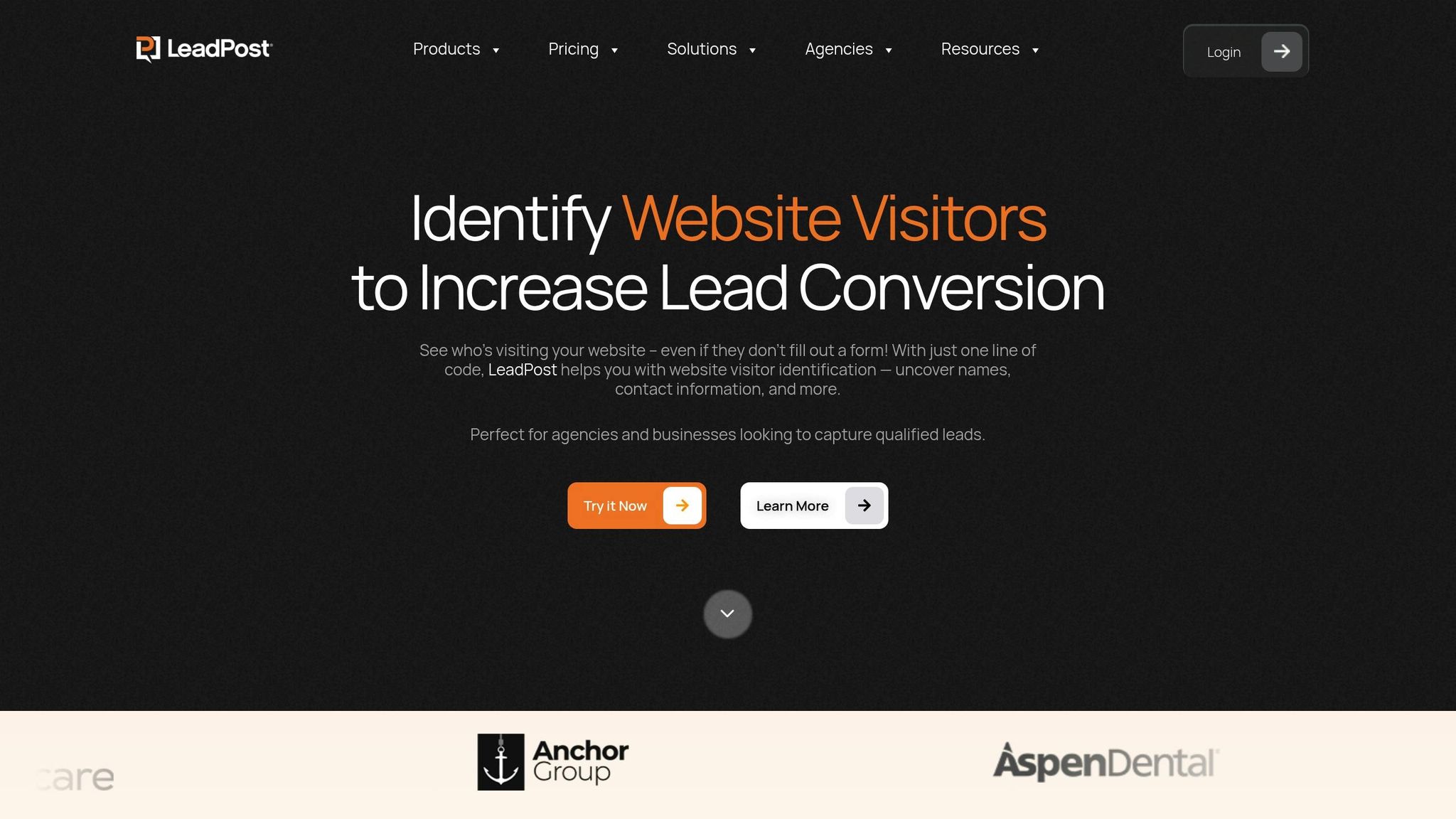
LeadPost is a tool designed to turn anonymous website traffic into actionable leads by capturing names, email addresses, and mailing addresses. It claims to convert up to 40% of such visitors into leads, making it a valuable asset for businesses looking to maximize their website's potential. With a 4.9/5 rating on GetApp and 96% positive reviews, it’s clear users appreciate its performance.
Cross-Device Retargeting
LeadPost ensures your brand stays visible across various devices and channels by using the contact details it collects. This consistent retargeting approach is particularly helpful for small businesses working with tighter marketing budgets.
"I love that this software allows even small businesses with low marketing budgets to enjoy the benefits of remarketing to site visitors who do not convert on the first visit." - Amanda T., CEO
Multi-Channel Ad Support
LeadPost supports a range of advertising channels, including display, email, social media, and direct mail. This flexibility allows businesses to maintain a cohesive marketing strategy across platforms, seamlessly integrating with their existing systems.
CRM and Analytics Integration
LeadPost connects with popular CRM and automation tools to simplify lead nurturing. The platform syncs visitor data automatically with tools like Mailchimp, HubSpot CRM, and Salesforce Starter. Its third-party integrations have earned a perfect 5.0/5 rating on GetApp, with compatibility extending to platforms such as Zapier, Constant Contact, Klaviyo, Campaign Monitor by Marigold, Robly, GetResponse, AWeber, and Zendesk Sell.
"An easy setup that now runs itself." - Jake B., Real Estate
6. Marin Software

Marin Software provides a unified platform designed to manage search, display, and social media campaigns, making it a go-to solution for businesses aiming to maintain consistent messaging across devices. With AI-powered automation at its core, Marin handles over $7.8 billion in annual ad spend across web and mobile platforms. Starting at $500 per month, it offers enterprise-level features and has earned a 4.1/5 rating on Software Advice and GetApp.
Cross-Device Capability
Marin excels at identifying users across devices and delivering targeted ads based on their previous interactions. For example, if someone visits a website on their desktop and later switches to mobile, Marin ensures they see relevant ads tied to their earlier activity.
"In the past, an advertiser wouldn't be able to detect when a site visitor switched devices. With Marin Display, we're empowering advertisers to deliver consistent messaging across devices." - Matt Ackley, Chief Marketing Officer and Senior Vice President of Product at Marin Software
The platform also includes cross-device conversion tracking, which helps advertisers measure the true impact of their mobile retargeting efforts. This feature is available for Enterprise Display and Perfect Audience users.
Supported Ad Channels
Marin functions as a comprehensive cross-channel platform, supporting search, display, and social advertising within a single interface. It integrates with leading mobile ad exchanges like MoPub and Nexage, giving advertisers access to premium mobile ad inventory. Additionally, Marin supports device targeting on Bing and, as a Facebook Marketing Partner, provides tailored solutions like Dynamic Ads for Travel.
"Travel advertisers now have a way to deliver thousands of relevant, customized ads dynamically across Facebook." - John McNulty, Vice President of Global Marketing at Marin Software
AI and Automation Features
Marin's AI-driven tools bring everything together by unifying data, identifying cross-channel opportunities, and automating campaign optimizations. With features like Marin Ascend, some clients have reported revenue growth exceeding 150%. Marin Insights offers personalized, AI-powered recommendations to enhance campaign performance, and users can automate these suggestions for ease of implementation. Automated bidding and AI-guided budget allocation ensure ad spend is distributed effectively across channels and devices, based on performance metrics.
Integration with Analytics and CRM
Marin integrates seamlessly with major platforms like Google, Facebook, and Amazon, offering a unified view of cross-device performance. Its tracking capabilities cover the entire customer journey. To further assist advertisers, Marin provides managed services for campaign optimization and strategic advice.
7. OptiMonk
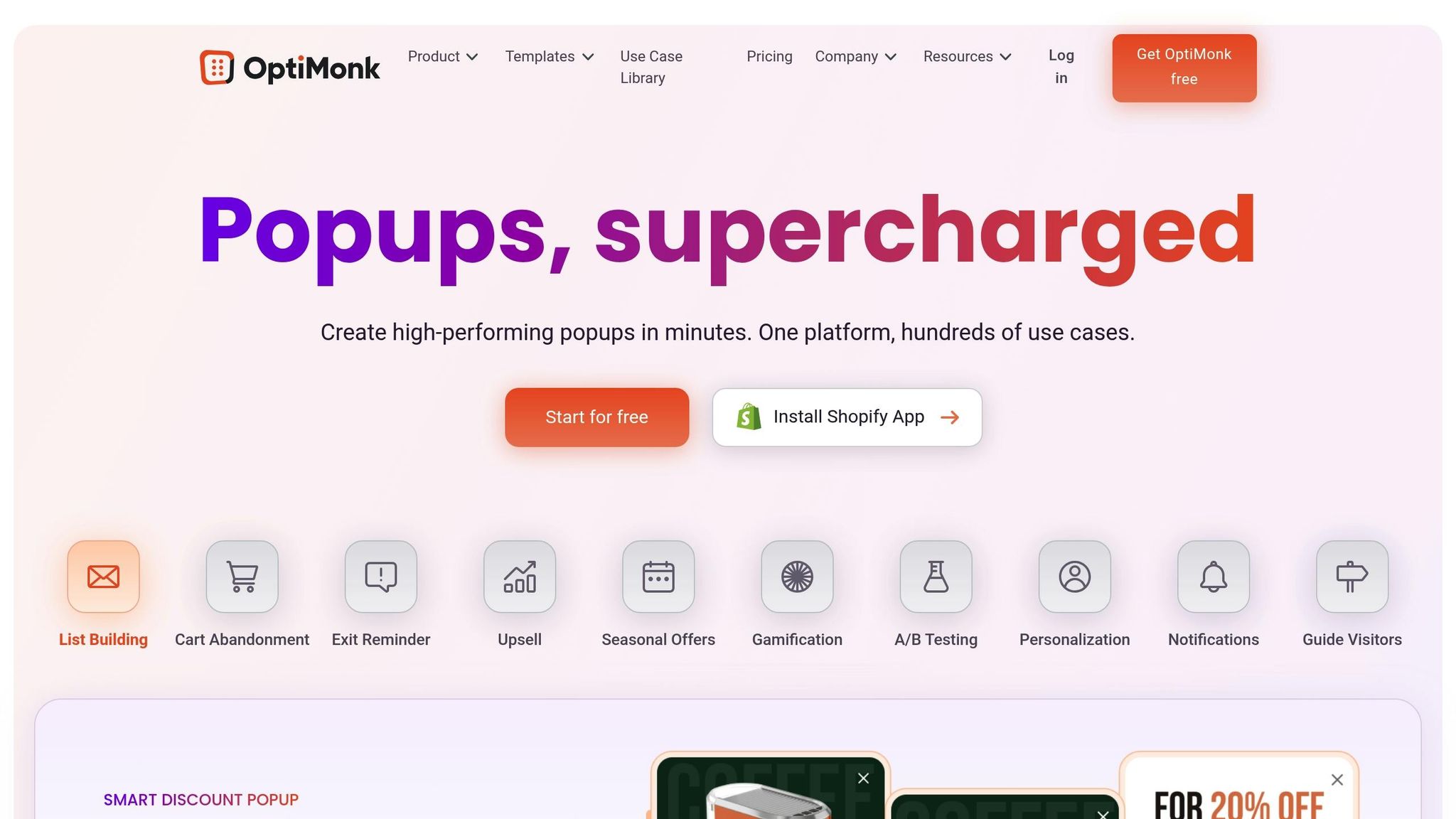
OptiMonk is all about onsite remarketing, focusing on using smart popups and personalized messages triggered by user behavior to re-engage visitors before they leave your website. This approach helps capture abandoning visitors at just the right moment. With a 4.9/5 rating on Software Advice and GetApp (based on 22 reviews), users praise its simplicity and affordability. It’s a great tool for boosting onsite engagement, complementing the cross-device strategies discussed earlier.
Cross-Device Capability
OptiMonk’s cross-device features are designed to recognize returning visitors and track their behavior across multiple devices. This allows businesses to deliver tailored messages based on previous interactions. Its mobile-friendly setup ensures your remarketing efforts are effective on both desktop and mobile platforms. The platform also uses exit-intent technology to capture data as visitors are about to leave, enabling personalized follow-up engagements.
"Personalization and segmentation. Behavioral targeting enables to treat your visitors as humans (not just 'users on a website')." - Gabor P.
AI and Automation Features
Currently, OptiMonk uses behavioral triggers to activate popups based on actions like clicks, scrolling, exit-intent, or time spent on a page. Looking ahead, the platform plans to integrate AI enhancements by 2025, including real-time bid and budget adjustments, to make automated remarketing even more effective. These updates align with broader trends in AI-powered campaign management.
"But what I like the most is that you can make money with Optimonk. There are lots of special features, that allow popups to be personalized and triggered at the best moment and place." - Zsolt D., CEO
Integration and Reporting
OptiMonk’s integration capabilities make it easy to track visitor behavior and create targeted messaging segments. Its reporting tools provide clear insights into campaign performance, helping you refine your remarketing strategy. One standout feature is the ability to create popup series, where each interaction triggers the next message in a sequence. This builds a cohesive funnel that guides visitors step-by-step toward conversion.
"It's reliable targeting and the ability to create popup series, each one triggering the next in the series." - Richard J.
Tool Comparison Chart
Choosing the right tool depends on your specific needs, budget, and technical requirements. Below is a breakdown of seven platforms, highlighting the core factors that influence campaign success and operational efficiency.
| Tool | Cross-Device Capability | Supported Ad Channels | AI/Automation Features | Analytics/CRM Integration |
|---|---|---|---|---|
| Google Ads | Advanced cross-device tracking using logged-in user accounts | Google Search, Display Network, YouTube, Gmail, Shopping | Smart Bidding, automated audience creation, responsive ads | Google Analytics, Google Tag Manager, most major CRMs |
| Meta Retargeting | Tracks user activity across devices via Facebook pixel when logged in | Facebook, Instagram, Messenger, Audience Network | Automated placements, dynamic ads, lookalike audiences | Facebook Analytics, custom CRM integrations via API |
| AdRoll | Cross-device identification through email matching and device graphs | Display, social (Facebook, Instagram), email marketing | AI-driven audience segmentation, automated bid optimization | Salesforce, HubSpot, Shopify, Google Analytics |
| Criteo | AI-powered cross-device tracking using shopper intent data | Display, social, Google Shopping, mobile apps | Real-time dynamic product ads, automated bidding, predictive audiences | Google Analytics, Adobe Analytics, major e-commerce platforms |
| LeadPost | Identifies anonymous visitors across devices and channels | Email, direct mail, display ads, social media | Automated visitor identification, lead scoring, campaign triggers | Salesforce, HubSpot, Mailchimp, Klaviyo, most major CRMs |
| Marin Software | Cross-channel attribution and device-level tracking | Paid search, social media, display advertising | Automated bid management, budget optimization, performance forecasting | Google Analytics, Adobe Analytics, Salesforce, custom integrations |
| OptiMonk | Tracks returning visitors through behavioral tracking | On-site popups, email integration, mobile optimization | Behavioral triggers, exit-intent technology | Google Analytics, email marketing platforms, basic CRM connections |
This table highlights the strengths and unique features of each platform. For example, Google Ads and Meta Retargeting excel in cross-device tracking by leveraging logged-in user data, ensuring seamless tracking across their ecosystems. On the other hand, Criteo is a standout option for e-commerce businesses, offering real-time shopper intent data to power dynamic product ads.
If you're looking for advanced AI automation, Criteo and AdRoll shine with their machine learning capabilities, optimizing campaigns and segmenting audiences across display, social, and email channels. For businesses with complex sales funnels, Marin Software and AdRoll provide robust CRM integrations. Meanwhile, OptiMonk focuses on boosting on-site engagement with behavioral triggers and exit-intent technology.
Each tool has its own strengths, so the best choice will depend on the specific goals and challenges of your campaigns.
Conclusion
In today's world, where U.S. consumers effortlessly switch between multiple devices throughout their daily lives, cross-device remarketing has become a crucial marketing strategy. With conversion rates from multi-device users soaring 230% higher than average, businesses can't afford to overlook this approach.
The tools discussed in this guide cater to a variety of business needs and budgets. Google Ads and Meta Retargeting shine when it comes to leveraging logged-in user data for smooth cross-device tracking. Meanwhile, Criteo and AdRoll bring AI-powered optimization to the table, making them ideal for businesses looking to fine-tune their campaigns. For those focused on lead generation, LeadPost offers effective visitor identification, and Marin Software delivers in-depth attribution across paid channels. Finally, OptiMonk provides robust on-site engagement features, rounding out the list with tools that address diverse marketing goals.
Retargeted ads are incredibly effective, generating up to 10x more clicks and increasing the likelihood of conversions by 70%. When choosing a cross-device remarketing platform, it's important to focus on tools with AI-driven optimization to maximize ROI. Additionally, ensure your platform complies with evolving privacy regulations and integrates seamlessly with your existing CRM systems for unified customer data [40,68].
Remarketing technology is advancing rapidly, as evidenced by the tools reviewed here. Automated campaigns are becoming smarter, thanks to machine learning and enhanced personalization features. To succeed, businesses need to map the entire customer journey, turn high-intent interactions into identifiable touchpoints, and feed unified data into their advertising systems.
As remarketing strategies continue to develop, staying aligned with current trends is key. U.S. businesses can explore the Top PPC Marketing Directory to compare tools and connect with expert agencies. This directory offers resources for retargeting, campaign management, performance tracking, and more - helping you find the right mix of tools and expertise to elevate your cross-device remarketing efforts.
FAQs
How does cross-device remarketing help boost conversion rates compared to traditional single-device approaches?
Cross-device remarketing helps businesses connect with users across smartphones, tablets, and desktops, creating a smooth and personalized experience. This approach ensures potential customers see consistent messaging, no matter which device they’re using.
By showing tailored ads throughout a user’s online journey, cross-device strategies improve visibility and build trust. This not only boosts engagement but also drives more conversions compared to focusing on a single device. It’s all about reaching the right audience at the right moment, making your campaigns more impactful.
How does AI improve cross-device remarketing campaigns and maximize ROI?
AI is transforming cross-device remarketing by making it possible to deliver more precise targeting, tailored ad experiences, and automated campaign management. This means marketers can connect with the right audience at the right time, regardless of the device they’re using.
With AI in the mix, businesses can cut down on unnecessary ad spend, boost conversion rates, and see a stronger return on investment (ROI). Its power to process and analyze massive data sets ensures that campaigns stay relevant and cost-efficient, delivering better outcomes across multiple platforms.
What should I look for when selecting a cross-device remarketing tool for my business?
When picking a cross-device remarketing tool, it’s important to focus on a few critical factors to match it with your business goals. One of the most important aspects is accurate cross-channel attribution, which helps you understand how customers interact with your brand across different devices. Choose a tool that integrates effortlessly with your current systems, like your CRM or analytics platforms, to keep your workflows smooth and efficient.
Another key feature to look for is automation. Tools with automation capabilities can save you time by fine-tuning campaigns and targeting the right audiences without constant manual input.
Don’t overlook privacy compliance either. The tool should meet regulations like GDPR or CCPA to ensure your customers’ data is secure and their trust in your brand remains intact. Lastly, weigh the cost against the features offered. Make sure the tool fits your budget while still delivering the functionality you need. By focusing on these factors, you can find a solution that simplifies your remarketing efforts and delivers stronger results.
